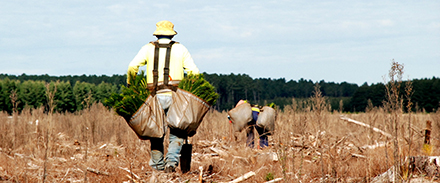OneFortyOne has welcomed the Federal Government’s simplification of access to carbon funding for forestry projects across five plantation growth regions, including the Green Triangle. The announcement means growers can participate in the Emissions Reduction Fund (ERF) through its plantation projects, where they previously could not because the area receives an average annual rainfall more than 600 millimetres. Source: Timberbiz
OneFortyOne Australia Executive General Manager Cameron MacDonald said the lifting of these regulations gives the forestry sector a greater incentive to plant more trees, capture more carbon from the atmosphere and create more jobs in regional areas.
“Through our membership of the Green Triangle Forest Industries Hub, OneFortyOne strongly supports the Hub’s strategic plan to make forestry a $2.5 billion sector for the Green Triangle by 2030, which would require a 10% increase in productivity,” he said.
“The strategic plan also has an ambition for the area to plant an extra 200 million trees, which would sequester an extra 3.6 million tonnes of carbon dioxide each year.
“The government’s announcement will go a long way towards helping the forestry sector in the Green Triangle achieve those goals.”
Mr MacDonald said OneFortyOne took its commitment to tackling climate change seriously, which is why it uses the internationally recognised Forestry Industry Carbon Assessment Tool to calculate how much carbon its forests sequester, and the amount of carbon emitted by all its operations over the same time period.
“In 2018, OneFortyOne’s tree growth and carbon removal far outweighed the emissions generated through our supply chain for the same time period, capturing more than 860,000 tonnes of carbon dioxide equivalent,” he said.
“Measuring a strongly carbon negative starting point is an important step in tracking our progress, but OneFortyOne would like to increase that number to 1m tonnes per annum over the next decade.
“By enabling the forestry sector to participate in the ERF, we can now generate carbon credits which gives us a greater incentive to reach that figure.
“OneFortyOne would like to congratulate the Federal Government on this announcement, which is the latest sign of strong support for the forestry sector along with the Bushfire Recovery Fund and the HomeBuilder Scheme.”
AFPA CEO Ross Hampton said that while it has always been possible for farmers and landowners to gain carbon credits for planting trees for environmental uses, it would now also be possible to bid for credits for production trees which will be processed into renewable products, and the area replanted.
“This is acknowledgment that half the mass of the tree is carbon which continues to be stored in the fibre-based products which are produced from the logs; from house frames to packaging,” he said.
“This welcome announcement also represents the Morrison Government making real its delivery of its ‘National Forest Industries Plan’ with its goal of planting another billion production trees by 2030.”
Barker MP Tony Pasin, whose electorate covers the Green Triangle, said there was plenty of demand with more than 900 million cubic metres of sawn softwood imported to Australia annually.
“The forestry industry has said for a long time that the previous regulations had been an impediment to plantation expansion,” he said.
“The industry already employs over 10,000 people in SA, more than 7000 of these are in the South East within the Green Triangle Hub area.
“It’s a big employer but it has the potential to grow.”
Major paper manufacturer Visy has described the decision as a “triple win” for the economy, the environment and the community.
“This important rule change is welcome news to Visy, Australia’s Forestry Industry and the 55,000 jobs it supports because it means new plantations, new investment and most importantly new jobs in regional forestry areas,” a spokesman said in a statement.
“The plan calls for establishing an initial footprint of new plantations of more than 20 million trees requiring an investment of over $200 million with scope for further investment beyond that.”






